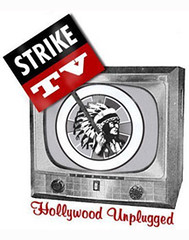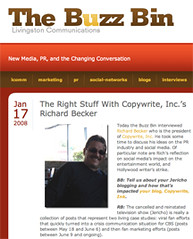Yesterday, the Writers Guild of America (WGA) and the Alliance of Motion Picture and Television Producers (AMPTP) began informal discussions to determine if there is a basis for both parties to return to formal negotiations. Restarting negotiations has not come soon enough.
For weeks now, the writers strike forced networks to scramble and offer an increasingly odd array of reality shows to the public. As long as people tune in, some of these quick creations might even replace a few favorites. For example, “American Gladiators” is surpassing the scripted show it replaced.
Advertisers are also discovering something about reality shows. Product placement is easier, at least according to yesterday’s story by The New York Times. And, reality shows seem well suited for “branded entertainment.”
“People are watching television; they're just not watching commercials,” said Lynda Resnick, chairwoman of Teleflora, the company that signed onto the NBC special “Teleflora Presents America’s Favorite Mom,” which is using the Internet to increase its presence. “That is the distinction.”
The concept of branded entertainment is not entirely new. Just one example that comes to mind is Mutual of Omaha’s Wild Kingdom. It is still going strong, though certainly not as top-of-mind as it was when I was growing up in a world where you had four choices as opposed to four million.
Revising branded entertainment and product placement options is one of several reasons the concept of old media seems dead to us. Not because we anticipate networks to die, but because they are acting more and more like new media.
As touched on in comments last week, some networks are intentionally pre-releasing episodes of some shows to help drive buzz with the hope that viral marketing occurs. Yet, buzz is not a measure nor do these prerelease promotions always consider writers and producers.
“Personally, I don't think running an entire episode as a "promotional" tool is smart business for the writers or the studios. Movie studios don't run their films free of charge for two and a half weeks, in the hopes that it will translate into paying customers later,” longtime Simpsons writer Mike Scully wrote on United Hollywood. “In my opinion, promotional use should have a limit of 3-5 minutes of program content, just enough to get the viewer to sample the show. However, if an entire episode is going to be made available, it should not contain any ads and should be limited to a window of no more than 48 hours. If they are being paid for promotional use, so should we.”
I tend to agree, and encourage people to read the full post. With the exception of a season one pilot, perhaps, I still don’t see how giving away a product, week after week, makes much sense, especially as people are become increasingly Internet savvy. At the very least, they are savvy enough to find downloadable content. BitTorrent, for example, continues to double its visitor volume every six months.
Then again, maybe all of this is a short-term problem as we seem to be trending to “On Demand” everything. Watch what you want, when you want it, and where you want it.
Long term, I can only imagine that this will result in some sort of tiered pricing structure that blends commercial free programming (rent or own) at a set price and commercial-laced programming for free (prerolls, pop ups, and bars) with product placement becoming as apparent as the parody we once laughed at while watching the movie Wayne’s World.
It won’t just change media, but the advertising industry as well. Maybe our culture too.

For weeks now, the writers strike forced networks to scramble and offer an increasingly odd array of reality shows to the public. As long as people tune in, some of these quick creations might even replace a few favorites. For example, “American Gladiators” is surpassing the scripted show it replaced.
Advertisers are also discovering something about reality shows. Product placement is easier, at least according to yesterday’s story by The New York Times. And, reality shows seem well suited for “branded entertainment.”
“People are watching television; they're just not watching commercials,” said Lynda Resnick, chairwoman of Teleflora, the company that signed onto the NBC special “Teleflora Presents America’s Favorite Mom,” which is using the Internet to increase its presence. “That is the distinction.”
The concept of branded entertainment is not entirely new. Just one example that comes to mind is Mutual of Omaha’s Wild Kingdom. It is still going strong, though certainly not as top-of-mind as it was when I was growing up in a world where you had four choices as opposed to four million.
Revising branded entertainment and product placement options is one of several reasons the concept of old media seems dead to us. Not because we anticipate networks to die, but because they are acting more and more like new media.
As touched on in comments last week, some networks are intentionally pre-releasing episodes of some shows to help drive buzz with the hope that viral marketing occurs. Yet, buzz is not a measure nor do these prerelease promotions always consider writers and producers.
“Personally, I don't think running an entire episode as a "promotional" tool is smart business for the writers or the studios. Movie studios don't run their films free of charge for two and a half weeks, in the hopes that it will translate into paying customers later,” longtime Simpsons writer Mike Scully wrote on United Hollywood. “In my opinion, promotional use should have a limit of 3-5 minutes of program content, just enough to get the viewer to sample the show. However, if an entire episode is going to be made available, it should not contain any ads and should be limited to a window of no more than 48 hours. If they are being paid for promotional use, so should we.”
I tend to agree, and encourage people to read the full post. With the exception of a season one pilot, perhaps, I still don’t see how giving away a product, week after week, makes much sense, especially as people are become increasingly Internet savvy. At the very least, they are savvy enough to find downloadable content. BitTorrent, for example, continues to double its visitor volume every six months.
Then again, maybe all of this is a short-term problem as we seem to be trending to “On Demand” everything. Watch what you want, when you want it, and where you want it.
Long term, I can only imagine that this will result in some sort of tiered pricing structure that blends commercial free programming (rent or own) at a set price and commercial-laced programming for free (prerolls, pop ups, and bars) with product placement becoming as apparent as the parody we once laughed at while watching the movie Wayne’s World.
It won’t just change media, but the advertising industry as well. Maybe our culture too.





















